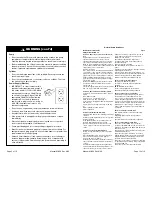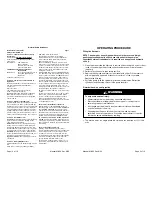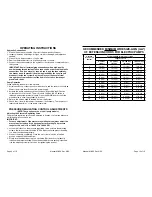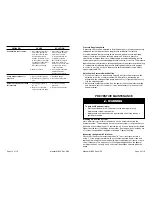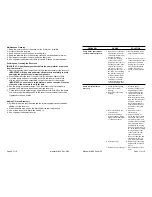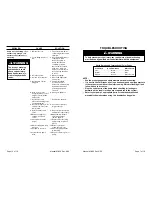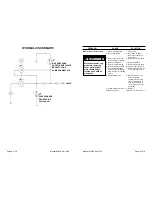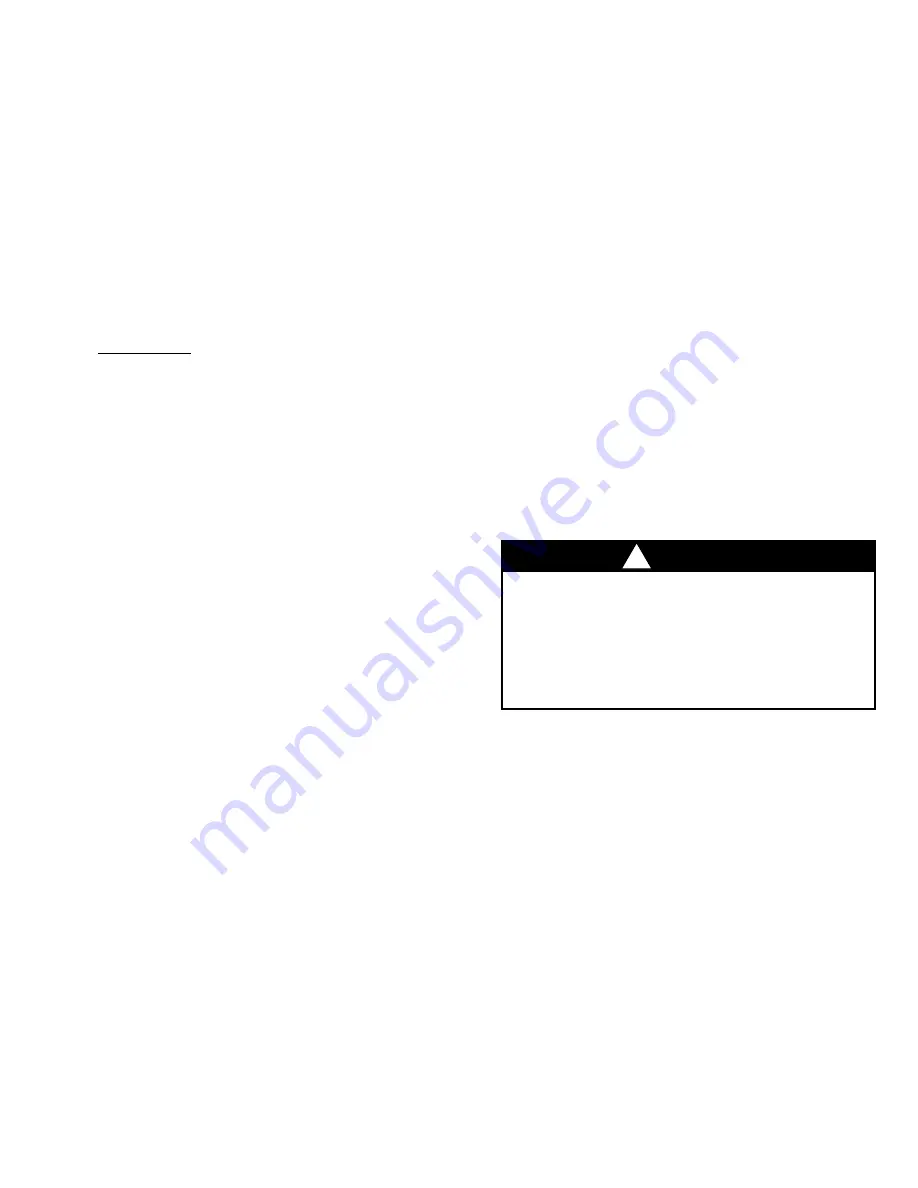
Manual M-800 Rev. 6/09
Manual M-800 Rev. 6/09
Page 3 of 16
OPERATING PROCEDURE
Filling the Reservoir
NOTE: The pump has been shipped without oil in the reservoir. A high-
quality, approved hydraulic oil has been shipped with the pump in a
separate container. If additional oil is required, use an approved hydraulic
oil only.
1. Clean the area around the filler cap to remove all dust and grit. Any dirt or dust
in the oil can damage the polished surfaces and precision-fit components of
this pump.
2. Retract all cyclinder(s) to their return position.
3. Remove the filler cap and insert a clean funnel with a filter. Fill the reservoir
with a high-quality, approved hydraulic oil to within 1” of the cover plate.
Replace the filler cap.
4. Cycle the pump (with the cylinder(s) attached) several times. Retract the
cylinder(s) and check the oil level in the pump reservoir.
Electrical Hook-up and Operation
To help avoid personal injury:
• All electrical work must be done by a qualified electrician.
• Disconnect the power supply before removing motor casing cover or
performing repairs or maintenance.
• All voltages must be wired for counterclockwise rotation when viewed
from the lead end of the motor.
• Changing the voltage on this unit is an involved, and if properly
performed, hazardous procedure. Consult the manufacturer for specific
information before attempting any rewiring.
WARNING
!
1. The electric motor is a single phase, 60 cycle and can be wired at 115 or 230
volts.
Page 14 of 16
Material Safety Data Sheet
Section 1. Chemical Product and Company
Identifcation.
Product Name:
AW Hydraulic Oil ISO 46
Code / Part Number: 9636, 9637, 9638, 9616,
11360, 9647
Manufacturer:
SPX Fluid Power
5885 11th Street
Rockford, IL 61109, USA
Phone: 815-874-5556
CHEMTREC 24 Hr. Emergency Number:
800-424-9300
Material Use:
The product designed for use in
heavy duty Hydraulic fluid
applications.
Validated on January, 2007
Section 2. Composition and Information on
Ingredients.
Name: Hydrotreated or severely refined base oil
and proprietary additives CAS#: Mixture
% (V/V): 100
Exposure Limits:
TLV-TWA (8 hr): 5mg/cubic m (oil mist)
STLE: 10 mg/cubic m (oil mist)
Manufacturer Recommendation: Not applicable
Other Exposure Limits: Consult local, state,
provincial or territorial authorities for acceptable
exposure limits.
Section 3. Hazardous Identification.
Potential health effects: Not irritating to slight irrita-
tion to skin and eyes with no permanent damage.
Relatively non-toxic via ingestion. This product has
a low vapor pressure and is not expected to pres-
ent an inhalation exposure at ambient conditions.
At high temperatures or mechanical actions may
produce vapors or mists. Inhalation may cause ir-
ritation of the breathing passages. See section 11.
Section 4. First Aid Measures
Eye contact:
Immediately flush eyes with running
water for at least 15 minutes, keeping eyelids
open. Seek medical attention.
Skin Contact:
Remove contaminated clothing –
launder before reuse. Wash contaminated skin
with running water and non-abrasive soap. Get
medical attention if irritation develops or if product
is injected under pressure into or under the skin.
Inhalation:
Remove to fresh air. Get medical at-
tention if breathing difficulty persists. If victim is not
breathing, perform artificial respiration.
Ingestion:
DO NOT induce vomiting. Seek medi-
cal attention.
Section 5. Fire-Fighting Measures
Flammability: May be combustive at high tempera-
ture.
Flash point: >=200 deg C (392 deg F) (COC)
Flammable Limits: Not available
Auto-Ignition Temperature: Not available
Fire Hazard in Presence of Various Substances:
Low fire hazard. This material must be heated
before ignition will occur.
Explosion Hazards in Presence of Various Sub-
stances: Do not cut, weld, drill or pressurize empty
container. Containers may explode in heat of fire.
Products of Combustion: various oxides of carbon,
nitrogen, sulfur, smoke and irritating vapors from
incomplete combustion.
Fire Fighting Media Instructions: NAERG96, Guide
171, Substances (low to moderate hazard). If tank,
rail car or tank is involved in fire, ISOLATE for 800
meters (0.5 mile) in all directions. Shut off fuel to
fire if it is possible to do without hazard. if it is not
possible, withdraw from area and let fire burn out
under controlled conditions. Withdraw immediately
in case of rising sound from venting safety device
or any discoloration of tank due to fire. Cool con-
taining vessels with water spray in order to prevent
pressure build-up, auto ignition or explosion.
Small Fire: use DRY chemicals, foam, water spray
or CO2.
Large Fire: use water spray, fog or foam. For small
outdoor fires, portable fire extinguishers may be
used. For all indoor fires and significant outdoor
fires self-contained breathing apparatus is re-
quired. Respiratory and eye protection are required
for fire fighting personnel.
Section 6. Accidental Release Measures
Material Release or Spill: NAERG96, Guide 171,
Substances (low to moderate hazard). ELIMINATE
ALL IGNITION SOURCES. Avoid contact. Stop
leak if without risk. Contain spill. Absorb with inert
absorbents. Place used absorbent in closed metal
containers for later disposal or burn absorbent in
suitable combustion chamber. DO NOT FLUSH
TO SEWERS, STREAMS OR OTHER BODIES OF
WATER. Check with applicable jurisdiction for spe-
cific disposal requirements of spilled materials and
empty containers. Notify the appropriate authorities
immediately.
Section 7. Handling and Storage
Handling: Avoid inhalation and skin contact
especially when handling used oil. Keep away from
sources of ignition. Do not reuse empty contain-
ers without commercial reconditioning. Practice
good personal hygiene. Wash hands after handling
oil and before eating. Launder work clothes fre-
quently. Discard saturated leather goods.
Storage: Store in tightly closed containers in cool,
dry, isolated, well-ventilated area, and away from
incompatibles.
Material Safety Data Sheet
Page 1
AW Hydraulic Oil ISO 46


